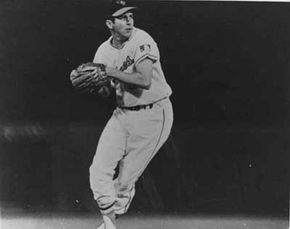The events of the 1960 baseball season were really rooted in a trade the year before. Over the winter that followed the 1959 season, in which the Yankees finished third, general manager George Weiss acquired Roger Maris via Kansas City for Hank Bauer, Don Larsen, Norm Siebern, and Marv Throneberry. Voted the Most Valuable Player, the 25-year-old left-handed hitter turned the trade into one of the century's greatest heists.
With Mickey Mantle contributing a league-high 40 round-trippers and Maris pounding the short right field porch in Yankee Stadium for 39 homers and a loop-best 112 RBI, New York had baseball's most devastating one-two power punch since Babe Ruth and Lou Gehrig. Another 26 homers from Bill "Moose" Skowron boosted the team to -- a major league -- high 193 homers.
Advertisement
The Yankees needed all the offense they could get, as not one pitcher won more than 15 games. Even the great Whitey Ford was limited to just a dozen triumphs. Ten different pitchers won five or more (for a pennant-winner, the Yanks had an unusually high 16 hurlers). The Yankees won their last 15 contests to take the flag.
Chuck Estrada of Baltimore, which finished 8 games behind New York, and Jim Perry of fourth-place Cleveland tied for tops in the American League with 18 wins. Ranked third, Chicago owned league ERA leader Frank Baumann, who posted a 2.68 mark. Batting champ Pete Runnels hit .320 for seventh-place Boston. Baltimore's Ron Hansen (22 homers, 86 RBI) was voted Rookie of the Year.
The National League champion Pittsburgh Pirates had a 20-game winner in Vern Law, who took Cy Young honors, and an 18-game victor in Bob Friend. The savior of the staff, however, was reliever Elroy Face, who won ten games and saved 24 others.
On the other side of the ball, Pittsburgh shortstop Dick Groat led the league in batting with a .325 average and won the MVP title. Groat beat out some tough competition -- Willie Mays (.319, 103 RBI), Hank Aaron (40 homers, a circuit-high 126 RBI), and Ernie Banks (a league-best 41 homers, 117 RBI). Budding superstar Roberto Clemente also sparked the Bucs offense with a .314 average and 16 home runs. Pittsburgh's unsung hero was 23-year-old second baseman Bill Mazeroski, who anchored the defense with flashy fielding.
Finishing 7 games behind Pittsburgh, Milwaukee had veteran Warren Spahn, who tied with Ernie Broglio of third-place St. Louis for most wins with 21. Mike McCormick posted a league-low 2.70 ERA playing for fifth-place San Francisco. Rookie Frank Howard of Los Angeles emerged with 23 homers.
Over the first six games of the 1960 World Series, the Yankees outscored the Pirates 46-17 but couldn't win more than three contests. Law took games one and four with relief from Face, and veteran Harvey Haddix won game five. Ford posted shutouts in games three and six.
Game seven turned out to be a classic. The Pirates blew an early 4-0 lead as the Yanks went up 7-4. The Bucs' five-run eighth inning was highlighted by reserve catcher Hal Smith's three-run homer. The explosive Yankee offense then notched two runs in the ninth to tie the game at nine.
Mazeroski led off the bottom of the ninth against Ralph Terry, who had stopped the Pirates' rally in the eighth. Up to that point, Mazeroski (.273 with 11 homers during the season) had knocked seven hits in 24 at-bats for the 1960 World Series, hitting a game-winning two-run homer in the first contest. Maz belted Terry's second pitch over Yogi Berra's head and the left-field fence for the win.
The Yankees, not taking defeat well, fired manager Casey Stengel, the 71-year-old master who had engineered all those flags in the decade of the 1950s.
The next page provides headlines and summaries for some of the top stories of the 1960 baseball season.
To learn more about baseball, see:
- 1959 Baseball Season
- 1961 Baseball Season
- Baseball History
- How Baseball Works
- How the Baseball Hall of Fame Works
- How Minor League Baseball Teams Work
- Babe Ruth
Advertisement

